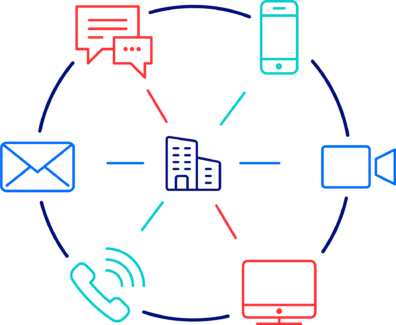Gone are the days of simplicity. The age of the internet has ushered in a new era of digital complexity, one that has fundamentally shifted the way consumers interact with companies. Paradoxically, customers may feel that access to any and all avenues of contact keeps things simple for them, while business owners may find it challenging to implement and manage numerous channels at scale.

In this piece, we will discuss the importance of omnichannel functionality, customer journey analytics, and how evolving consumer trends bring new expectations from customers interacting with companies.
Muti-channel vs. omnichannel
Before we begin, we need to clarify the difference between multi- and omnichannel and the implications of each, as we understand it. There are many definitions for both and they are applied in different contexts or industries; Take the word omnichannel. When applied in a more traditional marketing setting (+10 years), we would use omnichannel to describe the merging of the digital and physical touch- or sale points. Nowadays, as we’ll see, we recognize omnichannel as a strategy that extends beyond marketing.
Now back to the difference between the 2 words, often mistakenly (in our opinion) used synonymously. Let’s break down the distinction!
While the terms may appear similar, they convey a much different experience for the end-user and many different implications for the company administering and maintaining them. Multi-channel indicates a variety of consumer contact points that aren’t necessarily connected. In contrast, omnichannel refers to a broad user-engagement strategy in which a company provides cohesive accessibility to customers across channels, platforms, and devices.
The importance of omnichannel in marketing
An omnichannel marketing strategy enables optimal outreach and offers considerable strategic advantages by ignoring channel barriers and helping marketing departments measure the ROI of campaigns across multiple touchpoints and even across various devices. To keep things simple, we will focus on three critical advantages that make omnichannel strategies important to sales and marketing: greater reach, increased revenue, and customer satisfaction.
Greater reach
With potential customers switching between devices, social media platforms, and websites, it is essential for brands to be visible across all channels. Offering a wide array of engagement opportunities ensures the most significant consumer reach. With such broad visibility however, it is crucial to maintain consistent brand identity between devices, platforms, online experiences, and in-store interactions. Omnichannel marketing allows for more personalized advertising and facilitates generating marketing content informed by the current stage of the customer journey. Ideally, customer data will be tracked across channel engagement, whether in online logs or in-store loyalty cards, allowing a company to create a customer profile which provides strategic advantages for targeted marketing.
To summarize: a wider net catches more fish.
Customer satisfaction
It’s clear that greater reach from omnichannel marketing is beneficial to the company, but how does this influence the customer experience? Well, the customer should have effortless accessibility to your brand, and feel that they are not being asked to step outside their usual domain of aptitude just to reach you. Acknowledging customer preference is key, if it is inconvenient for customers to interact with your brand, or if marketing content is not being received due to improper omnichannel deployment, they will likely not be inspired to do business with you. In fact, research from Omnisend in 2019 found a 90% increase in customer retention rates when additional channels were available, indicating that customers are more likely to continue business with companies that are easy to work with.
Increased revenue
A 2020 study conducted by Omnisend.com showed an impressive 287% improvement in engagement and purchase rates when companies offered three or more channels to customers. This evidence supports the narrative that customers are more likely to support businesses that provide convenient engagement through omnichannel integration.
Great, but you might be thinking, how do the lessons learned in omnichannel marketing help customer service?
Marketing tends to be at the forefront or the avant-garde of our customer relationships. It’s exceptionally measurable and actionable. If something works, we do more of it; if it doesn’t, no foul—we will try a different tactic. Being uncalculated with your customer service and trying things for the hell of it is far less advisable. …
The importance of omnichannel in customer service
Marketing and customer service are two sides of the same customer experience coin. One is incomplete without the other. If a company offers a spectrum of engagement in regards to marketing, the customer will eventually expect the same accessibility in the customer service experience. Blending these two solutions allows true cohesion throughout all points in the customer experience.
Omnichannel customer service allows customers support across several channels: phone, live chat, email, social media, etc. Additionally, omnichannel customer service allows for much more streamlined data management, with support channels in sync and documenting the customer journey to best support them throughout the process.
Acknowledging varying consumer preferences
Consumer trends are constantly changing, and the fluctuations seem to be magnified by our ’24/7 always on’ culture. As more of our lives are spent in the digital realm, our online experiences become increasingly personalized. With such a high degree of personalization, consumers expect to interact with companies in whichever way is most convenient. Research conducted in 2018 by PwC, surveying 15,000 people across 12 countries, concluded that 43% of consumers would pay more for greater convenience, and 73% of people say customer experience plays an important role in their purchasing decisions.
It follows then that customers desire quality service convenient to their lifestyle and that these factors greatly influence their willingness to do business with a company. Customers vary widely in the way they communicate, especially across demographics; some want a simple phone call, while others may find calling unnecessary and prefer a text or email. In fact, research from found that 75% of millennials avoid phone calls altogether, and 81% experience anxiety when calling. Developing an omnichannel service strategy and deploying comprehensive functionality ensures that customers can interact in their preferred method and increases the likelihood of a satisfactory experience. Companies that acknowledge the difference in customer preference and leverage omnichannel solutions are best positioned to appeal to a wide range of consumers.
Focus on consistency across channels
The omnichannel discussion would be incomplete without significantly highlighting the importance of consistency. As mentioned earlier, what separates a multi-channel from a true omnichannel solution is the ability to seamlessly flow between channels without compromising the quality of the experience. Whether a customer is buying a product, requesting support, or otherwise engaging with a company— the experience should feel synergistic. A properly deployed omnichannel solution is cohesive and free from communication friction, data discrepancies, and obvious inconsistencies.
A common complaint from customers is that they often have to repeat information when navigating between channels. Data collected from the CMO Council in 2019 shows that 84% of respondents find it frustrating to start over in a new channel every time they switch; meanwhile, 85% of consumers still want a blend of physical and digital channels. This indicates a clear message from consumers to companies: have multiple channels, but please make sure they are consistent with each other.
Cross-channel consistency not only satisfies the customer, it also generates a higher degree of customer relations management efficiency for the business. When channels communicate correctly, data management is considerably less painful, and comprehensive customer journey tracking becomes possible. In addition, companies can leverage the collective data to better understand which of their tactics have the greatest ROI, where their weaknesses reside, and how to better deploy resources to improve their marketing and CX strategy.
Customer journey
When omnichannel marketing meets omnichannel customer service and properly managed data collection, creating a highly personalized, insight-rich customer journey becomes possible.
The customer journey begins with the first interaction with a company and persists through every interaction thereafter. Ideally, each customer’s interaction across every touchpoint will be documented, creating a customer journey map. The idea is to generate a comprehensive At an agent level, these customer journey maps can be used to better understand the customer in real-time. At the contact center or even a strategic CX level, compiled and analyzed data can be used to highlight trends that help you focus on what matters.
A customer journey map is critical to effectively developing omnichannel functionality, as marketers can better target individuals where they are, and service reps can better support customers across any channel.
Final thoughts
It’s likely impossible to satisfy every customer in every interaction as there are simply too many variables at play. But you can give your agents tools that help make the most of any scenario across all channels. With customer expectations fluctuating as personalized service becomes the prevailing standard, the optimal business strategy involves an omnichannel customer experience approach, offering personalized and cohesive accessibility across the customer journey.





